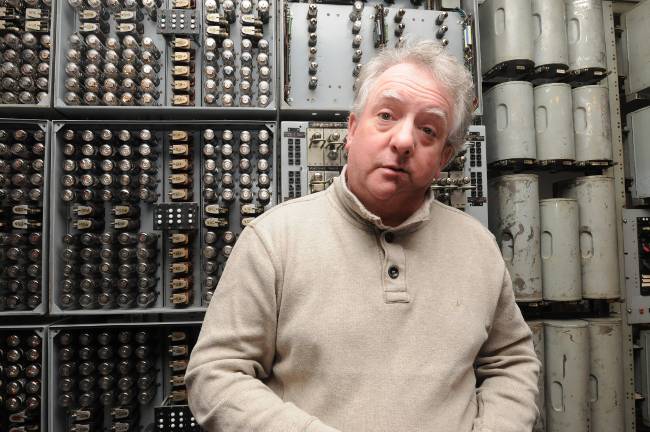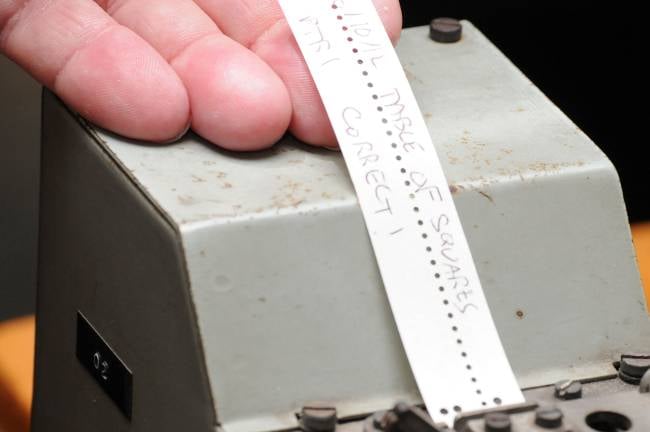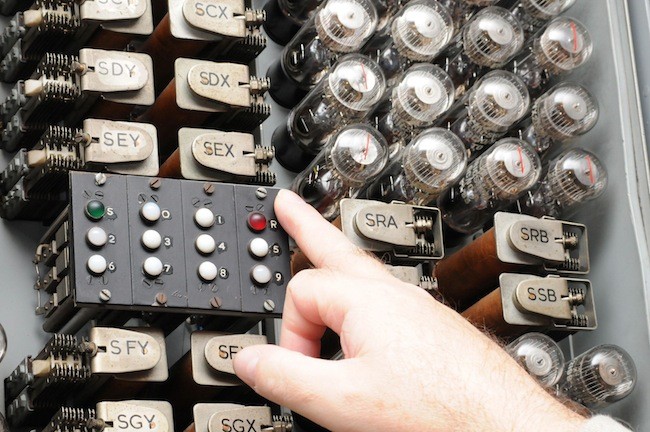Original URL: https://www.theregister.com/2012/11/21/harwell_dekatron_reboot/
DEKATRON reborn: Full details on World's Oldest Digital Computer
OK iPad kids, let's see how you do on paper tape
Posted in On-Prem, 21st November 2012 12:45 GMT
Feature The world’s oldest working digital computer was rebooted on Tuesday following a painstaking three-year refurbishment. The slow-but-steady machine will now be used to educate school-age programmers.
The Harwell Dekatron – AKA The WITCH Computer - crunched its first calculations 61 years ago and was used to build Britain’s first nuclear reactors. It has been restored by The National Museum of Computing (TNMOC) at Bletchley Park.
At an unveiling ceremony following the rebuild work, one of the Dekatron's early users Bart Fosey, 85, raced the machine using a modern hand-calculator to see which completed its task first. The race was declared a draw.
Now students visiting TNMOC can build programs on a PC and convert the code to paper tape to be run on the cleaned-up computer.

The paper tape output by the machine
“They get to produce something and then run their program on the actual hardware,” Kevin Murrell, the TNMOC fellow who restored the Dekatron, told The Reg. He explained the appeal of this old clunker: “Because the machine was never designed to be fast, we can follow its thinking.”
Murrell has something of a life-long relationship with the Dekatron: he first saw it in a museum in the 1970s. At the time the physics student was building his own computer kits, and eventually defected to computing.
TNMOC is regularly visited by students who program its collection of BBC Micros, and with so many school groups coming through its doors it’s booked past Christmas. Now the WITCH refurb project will not just to save one of the first digital computers from the scrap heap, it will also inspire others as a hands-on exhibit.
When you think of old room-sized computers, your mind may turn to Colossus - the beast designed by Tommy Flowers that was used to crack the German military's encryption codes during the Second World War. A Colossus replica sits in the low-rise maze of war-era brick huts at TNMOC.
Or perhaps you may think of the US Army’s Electronic Numerical Integrator And Computer (ENIAC), considered the world’s first general-purpose electronic computer. It was designed and built around the same time as the Dekatron, and used to calculate missile trajectories; it was also operated by a team of women whose job title was “computer” – a first in a sector then, as now, dominated by men. The last living member of the pioneering team was Jean Bartik, who died last year.
The restored Dekatron is not a replica: it has been rebuilt from original parts and its use by visitors is encouraged - unlike the ENIAC on display at the Computer History Museum in Mountain View, California: you can look but you can’t touch that monster – it’s for display purposes only.
The WITCH is a simple beast. Rather than follow the architects of ENIAC and build a general-purpose computer, its creators kept it simple: they built a 2.5-ton calculator that ate numbers and spat out answers.
Of the original Dekatron team, Ted Cooke-Yarborough designed the electronics; Dick Barnes made the relays, and control and timing electronics; and Gurney Thomas created the Dekatron memory.
“This was purely a mathematics machine,” museum spokesperson Stephen Fleming told The Reg. “It’s the number cruncher of its time.”

Dekatron man: Murrell with the machine he helped rebuild
The Atomic Energy Research Establishment - known simply as “Harwell” after its base near Harwell, Oxfordshire - commissioned the cruncher to automate the boring work assigned to a team of six university-educated mathematicians pounding Brunsviga calculators, who could easily make mistakes.
The machine was used in fundamental research and to design early power stations producing electricity for the national grid, including the Calder Hall nuclear plant. It calculated properties such as the ideal thickness of the nuclear reactor’s concrete housing.
A simple division would take the Dekatron more than 10 seconds to complete, but speed was never the issue - as proved by this Tuesday's test. Reliability was the problem.
The Dekatron isn’t unique. It’s a relay computer not unlike the Imperial College Counting Engine from the same era and the German Z3 in 1941. What helped it stand out, though, was its particular use of electronic components made of gas-filled glass tubes that could count to ten.
These Dekatron devices were in use from the 1940s until the 1970s for computing, calculating and frequency-division jobs. Each Dekatron is packed with a ring of paired electrodes that emit a soft neon light when powered up. The electrodes light up in sequence every time an input signal is detected, producing what looks like a moving dot that completes revolutions inside its tube; one revolution indicates 10 electrical pulses have been received. Each electrode pair is twinned with a cathode that outputs a signal when the electrode is lit up. These signals can feed into other tubes as input pulses, thus building up a chain of counters and frequency dividers.
Storing information in an age when filling ram sockets was an entirely different business
The Dekatrons didn’t just count - they also stored data by acting as a volatile memory similar to RAM in today’s computers. This meant the machine could run unattended and results wouldn’t be lost until it was powered down.
The Dekatron has 828 Dekatron tubes. Also, there are 480 relays, 7,073 contacts or relay switches, 26-high-speed relays, 199 lamps, 18 switches, a 1.5 kilowatt power supply, thousands of connectors, some sheet-metal casing and a metal frame measuring 6m across, 2m high and 1m deep.
Kevin Murrell, who started restoring the beast in 2009, likened assembling the machine to raising the Mary Rose. For non-students of history, this warship was the pride of King Henry VIII’s fleet and sank in 1545. In 1982, the surviving part of its hull was delicately raised by crane from The Solent, near Plymouth, and placed in a climate-controlled museum.

Old-skool program: how to build a sub-routine for the Dekatron
You’d think the TNMOC team that rebuilt the Dekatron had a relatively easy job: unlike the Mary Rose’s archaeologists, they weren’t labouring in freezing water, breathing bottled oxygen, and scrambling through zero visibility.
However, like the Mary Rose, the computer was in pieces.
Harwell ran the Dekatron from 1951 to 1957, and then gave it to the Wolverhampton and Staffordshire Technical College. It was renamed WITCH (Wolverhampton Instrument for Teaching Computation from Harwell) and used it for teaching before it was handed over to the Birmingham Museum of Science and Industry in 1973. This is where Murrell first encountered the machine. Years later, it was taken apart and put into boxes for storage at the Birmingham Collections Centre. The Dekatron moved to TNMOC in 2009.
Murrell had manuals to work from, but this was only partially helpful.
“We had all the components and various circuit diagrams,” Murrell said. “But the diagrams aren’t that helpful. We knew physically where the bits went, but a lot of wiring has suffered in storage, some tubes had failed and spare parts had to be sourced.”
Broken Dekatron-like valves could be sourced, unused, from Russia – they’d been made during the glory days of the Soviet Union. The relays, distractingly labelled with SEX and other terms, are the type used by the General Post Office (GPO) of the era, and were relatively easy to replace if broken. Other components were scrubbed clean of decades of oxides using brushes and file filters.
Some of the cabling had rusted and was replaced with modern white-coloured plastic-coated stock that's hidden around the back; also updated is the original power source, which Murrell called “impressively terrifying”.
Before Tuesday’s reboot, Murrell and TMOCH ran simple programs to test different parts of this 2.5-ton calculator. Their program calculated the squares of multiple lists of numbers.
Back at the dawn of the nuclear age, software for the Dekatron was designed using a pencil-drawn flowchart, and written down in longhand on foolscap sheets of lined paper. The source code was taken to a punch-tape machine and the instructions punched onto paper – one program could have up to six paper tapes, and lots of spools would need to be glued into a loop so that it ran continuously.
Data for the computer was also punched on paper tape. Results from the calculations were printed by a teleprinter and could be punched directly to a new paper tape - useful if the output was needed for a new calculation.
Today, the programs are written in longhand with the help of Microsoft Excel, but otherwise it’s business as usual. Programs are transferred to paper using a hole puncher on a table next to the Dekatron and the results are collected from a teleprinter on the opposite side of the machine.
Sixty years on, the Dekatron is ready for a new generation growing up in a world of iPad apps and Visual Studio. Now they can try sailing the Mary Rose of computers - let's see how far they can get. ®
